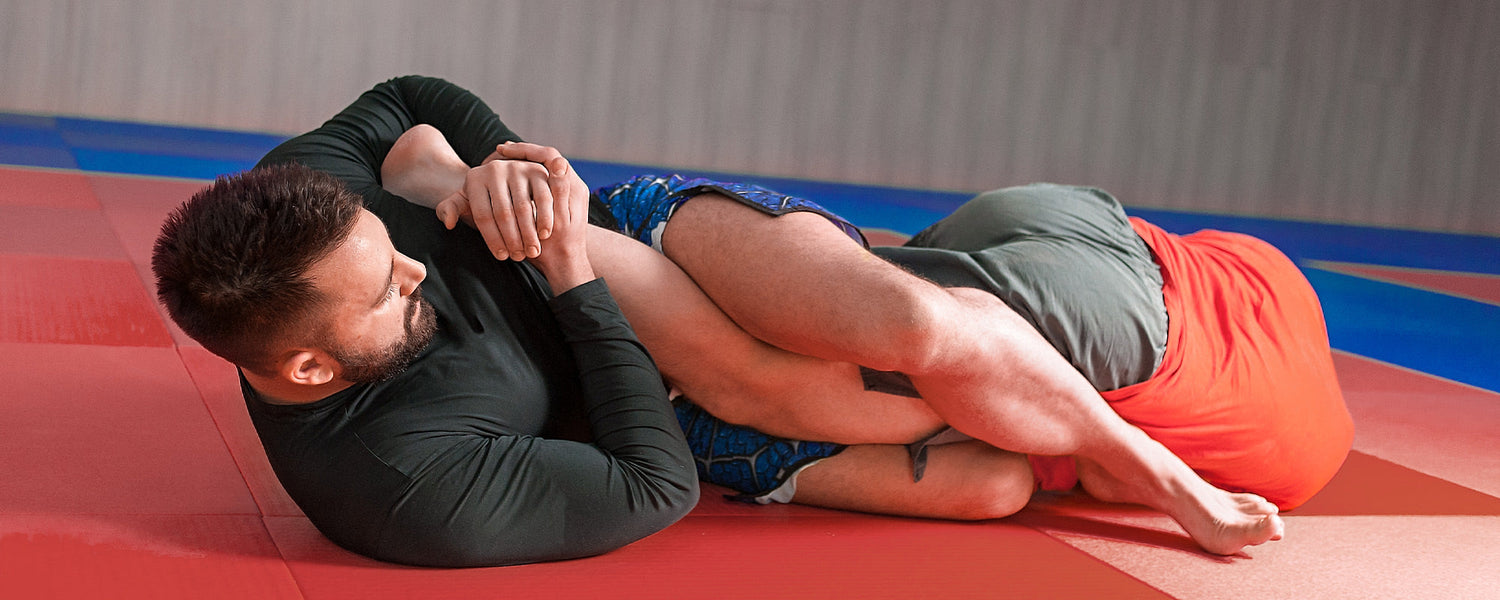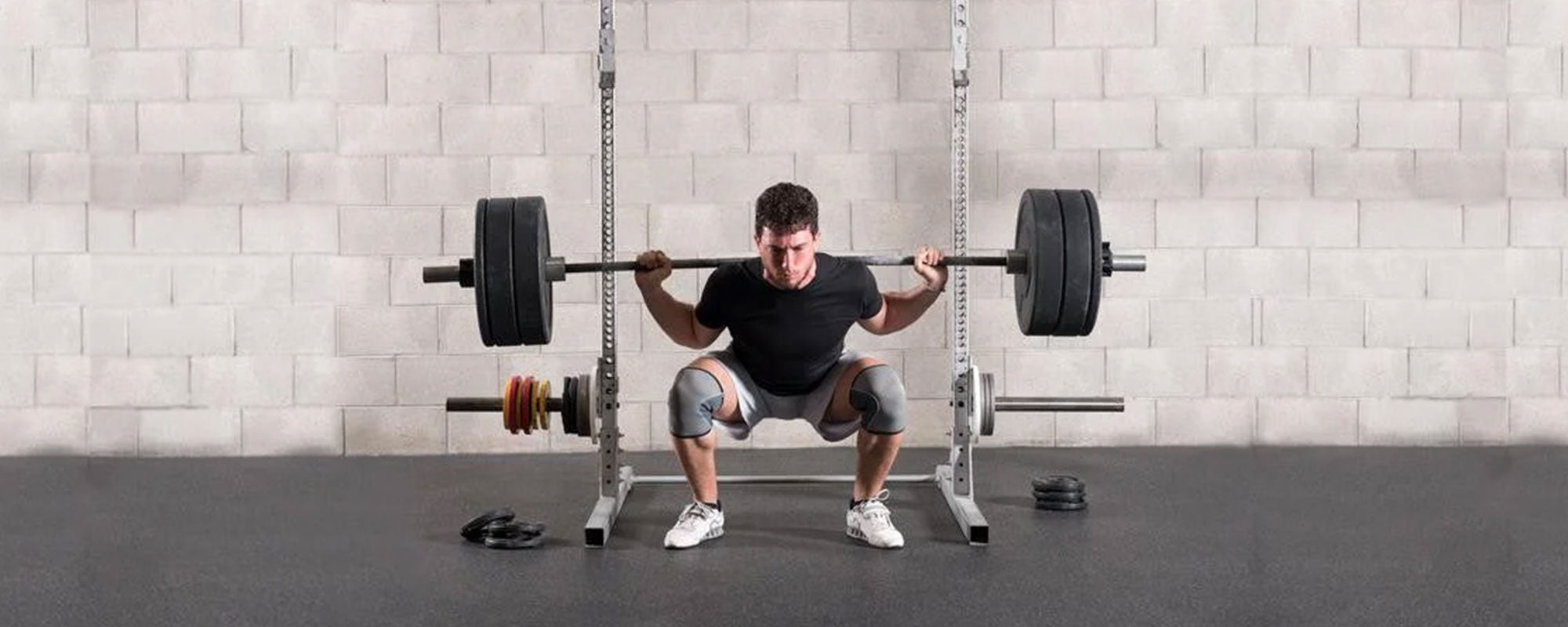Table of content
If you are looking for a quick yet painful submission to make your opponent tap out, compression locks can do wonders for you. In Brazilian Jiu-Jitsu, they are severe but can help you make your submission attempts successful. They are equally effective for both GI and No-Gi BJJ. However, they can result in severe injuries like torn ligaments, arm dislocation, and torn muscles. Therefore, if you ever get stuck in any of the compression locks and you feel that the pressure on your muscles is more than you can bear, tap out as soon as possible to avoid such injuries.
In this post, you will learn what compression locks are, how they work, how you can use them to your advantage, and possible ways to defend against these locks.
1. What Are Compression Locks?
A compression lock is a grappling hold in which you press one of the muscles on the body of your opponent against their bone. This causes pain and makes opponents tap out instantly. Compression locks are also known as muscle locks, muscle crushers, and muscle slicers.
They are deadly enough that if your opponent does not tap out or you apply the technique with a considerable amount of force, it can result in the tearing of the compressed muscle. The Achilles lock, bicep slicer, and calf slicer are the most common versions of a compression lock.
2. Top Compression Locks In BJJ
As mentioned above, there are three major versions of compression locks in BJJ and they are listed below:
2.1. Achilles lock (Ankle Lock)
If you are looking for one of the supper effective ways of submission within the legal limits of the IBJJF, you should go for an Achilles lock that is also called the ankle lock and straight foot lock. This is one of the tried and tested submissions and is more effective than any other leg lock system.
You can find this compression lock technique used in various grappling arts, including BJJ, Catch Wrestling, Judo, and Sambo. In Judo, this compression lock is called Ashi-Hishigi. The execution technique and finish are the same in all these grappling arts.
How Does It Work?
A perfect Achilles or ankle lock places downward pressure on the instep of your opponent’s foot while holding the whole leg in place. It always results in the plantar flexion of the opponent's ankle as you bend or hyperextend it beyond its normal range of motion, resulting in straining and surrounding ligaments. The strained ligaments cause pain to the opponent, which makes them tap out or results in severe damage to the Achilles' muscles.
How To Execute?
To perform the Achilles/ankle lock, you wrap your attacking arm around your opponent’s leg while using your wrist or forearm as a fulcrum underneath the Achilles. In this process, your upper lat should be near your armpit area and should be contacting the opponent’s instep. You will be using your free hand for supporting your attacking hand for stabilizing and reinforcing the hold. As soon as the hold is secured, you can apply the submission by applying upward pressure on their Achilles while pressuring downward on their instep by arching your back.
Common Achilles/Ankle Lock Entries
This compression lock is usually applied from the ashi garami position, in which the leg configuration is utilized for applying counter pressure on the hip of the opponent while holding their leg in place. While doing so, the pressure should be focused on the ankle.
Defend It
Besides knowing how to perform ankle locks, it is also vital to learn how to defend them if you get stuck in a submission attempt by your opponent by applying the same compression lock. Here are some techniques that you can use to defend the Achilles/ankle lock effectively.
- Stand Up: The best way to defend the ankle lock attempt is by standing up. Though your opponent will still be able to sweep you for the submission, by standing up you will be able to defend the submission and escape.
- Straighten Your Feet: To complete the ankle lock submission, your opponent will need your leg arched down at a specific angle. So, by straightening out your foot and tightening up your leg, you can defend it effectively. However, you will still be in trouble, but doing so will provide you with the time to escape from the submission.
- Get Your Knee Free: To make any leg lock, your opponent needs to be controlling your leg above your knee. If you can get your knee free by pushing up your opponent’s leg, you can easily get out of the submission.
2.2. Bicep Slicer
The bicep slicer, or bicep lock, is another outstanding technique to cause pain to your opponent and make your submission attempts successful. This compression lock is known for its lethality, and it is not easy to counter. To do so, avoid getting into the position.
However, the right application causes enough pain in a very short time that it does not provide you with any answer other than tapping out. A little late in tapping out can cause severe injuries to your bones, such as joint or ligament dislocation.
How Does It Work?
This element that makes the bicep slicer a compression lock is the pressure put on the opponent’s locked in place. This is also a great position to go for an armlock as the force is applied in the same way and can cause the separating tension or a stretch in your opponent’s elbow joint.
How To Perform?
To perform a bicep slicer with perfection, you will need to put pressure over your opponent’s arm with your arm or leg like a fulcrum and lock it with the help of your elbow by flexing it over the fulcrum that you have made. This will suppress the forearm and biceps of your opponent and will make them feel pain when the bony part of your elbow or leg impacts their muscles while performing the move.
For further information on the execution of bicep slicers, the following video by Howcast can help.
Transition To Biceps Slicer
The bicep slicer is one of the most versatile moves that you can perform from various positions, as you can perform it with both arms and legs. The bicep slicer from the armbar and the failed armbar are the most common examples of transition options for this move. For example, if you are unable to break your opponent’s grip when they counter your armbar, you just have to wrap your leg over their chest and then around their forearm to go for a triangle lock. From here on, you can apply pressure with your legs to make them tap out instantly.
Also read: Top 6 Deadly Arm Locks in BJJ
Defend It
As the bicep slicer is one of the most lethal moves, there is very little room for you to defend it other than by tapping out instantly to avoid getting your muscles torn. However, every fighter could not perform it well, and in the way they should be doing it, it provides you an opportunity to escape from this dangerous submission. In this regard, you can wind up your legs like you're about to roll yourself, but you have to kick downwards and sit up to stack the opponent, and now you are out of danger.
If you are unable to whip your legs due to the opponent's control over your hands and legs, you can go for bridging to roll over your opponent and take control of them before they make you tap out. This video by Sambo Fusion can help you learn the escape from the bicep slicer more effectively.
2.3. Calf Slicer Or Calf Crusher
Among all the basic leg locks, the calf slicer, or calf crusher, is the least known, and the most prominent reason behind this is its application from a limited number of positions. This technique is also used in sambo and submission wrestling, besides in BJJ.
How Does It Work?
Unlike other leg locks, the calf crusher is a compression lock that is used to put pressure on the opponent's muscles instead of joints. Though the main target of this technique is to pressurize the calf muscles, it can cause collateral damage to the joint and the knee more than the calf muscles, which makes this technique lethal. That is why, for the lower belts, this technique is illegal to perform in any IBJJF competitions.
How To Perform?
To perform a calf slicer, you need to place a fulcrum with the help of your shin behind the opponent’s knee and fold the leg to pull on their instep or ankle. By doing so, the calf muscle will squeeze between your opponent and your shin. This will cause severe pain and may also rupture the calf muscle.
The following video by Knight Jiu-Jitsu can help you understand the execution of this technique in detail.
Key Variations
There are multiple positions from where you can implement the calf slicer. You can execute this technique from X guard, mount, turtle position, deep half guard, and many others.
Calf Slicer From X Guard
According to BJJ professionals, the best position to perform the calf slicer is x guard. When you get into the x guard position, you only need to imbalance your opponent and raise him a little. From the X-guard position, take off your foot from your opponent’s hip and go under the leg that you are targeting.
The next step is to triangle your legs, along with getting a robust gable grip. To complete the move, raise your hips and grip down to apply pressure to their calf to make them tap out.
Calf Slicer From Top Half Guard
The other great position for applying a calf slicer to your opponents is from the top half guard. In this position, you pull your leg out to free your knee and roll the same shoulder that is strangled in the opponent's legs. From this point forward, the roll is executed in a manner similar to the roll performed in the "truck" position. Also, the finishing would be in the same fashion as what you might be doing in the truck position.
Defend It
Always be aware of the moves of your opponents and do not let them put their shin under your calf. If you provide them the opportunity to do so, you will be in severe pain and will surely tap out to avoid severe injuries. Therefore, do not let them get hold of your foot to pull it down and ensure that the opponent's shin is far away from your calf.
3. IBJJF Regulations About Compression Locks
Considering the severity and lethality of compression locks, the IBJJF has set certain regulations and has imposed conditions on the execution of the above-stated muscle locks. Though ankle lock is also a dangerous move, it is allowed for white belts and higher ranks. However, kids' athletes are not allowed to use this move during IBJJF competitions.
The other two compression locks such as bicep slicer and calf slicer are prohibited to most of the belt ranks in the BJJ owing to their lethality and severity for the opponents. They may cause torn muscles, dislocated joints, and even bone breakages. These are the reasons that IBJJF has allowed both techniques to brown and black belt holders only.
4. Takeaway
Due to their lethality, compression locks are the favorite of a large number of grapplers, but the regulation of the respective authorities has limited their use to pro fighters only. So, if you are a beginner in the sport, do not try to use these lethal moves unless you reach the rank where they are allowed to be executed and to make your opponents tap out instantly. However, if you are a brown or black belt, having them in your arsenal can help you win most of the games.
Photo Credit: depositphotos












Leave a comment
This site is protected by hCaptcha and the hCaptcha Privacy Policy and Terms of Service apply.